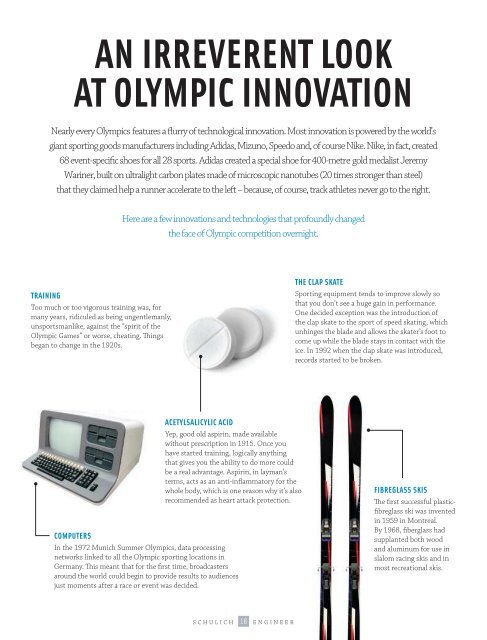high performance - The Schulich School of Engineering - University ...
high performance - The Schulich School of Engineering - University ...
high performance - The Schulich School of Engineering - University ...
- No tags were found...
Create successful ePaper yourself
Turn your PDF publications into a flip-book with our unique Google optimized e-Paper software.
AN IRREVERENT LOOKAT OLYMPIC INNOVATIONNearly every Olympics features a flurry <strong>of</strong> technological innovation. Most innovation is powered by the world’sgiant sporting goods manufacturers including Adidas, Mizuno, Speedo and, <strong>of</strong> course Nike. Nike, in fact, created68 event-specific shoes for all 28 sports. Adidas created a special shoe for 400-metre gold medalist JeremyWariner, built on ultralight carbon plates made <strong>of</strong> microscopic nanotubes (20 times stronger than steel)that they claimed help a runner accelerate to the left – because, <strong>of</strong> course, track athletes never go to the right.FIBREGLASS POLE VAULTFibreglass poles totally changed the sport <strong>of</strong>pole-vaulting when they replaced bamboo.When first used, it moved the Olympicstandard by 3 inches up to 15 feet and 10inches. At the next games, in 1972, theserecords where smashed when the perfectedfibreglass “cata-pole” allowed a US jumper tovault 18 and a half feet. Moreoever, it alsochanged the technique <strong>of</strong> the sport, withathletes developing the “catapult” techniquedue to the flexibility <strong>of</strong> the new poles.THE SPEEDO LZR RACERDuring the 2008 swimming world championships in Manchester, England,a curious spectacle emerged. Nearly every race resulted in a new worldrecord. <strong>The</strong> swimmers however seemed more embarrassed than jubilant.At issue was Speedo’s LZR (pronounced ‘laser’) Racer swimsuit. <strong>The</strong> suitsquashes, flattens and compresses swimmers into aerodynamic shapes thatstrategically reduce drag. Critics say that the special polymer panels resistwater, making the swimmer more buoyant. So far 93 world records havebeen broken – or smashed – by swimmers wearing the LZR Racer. It is nowillegal in Canada and will be banned internationally in 2010.TRAININGToo much or too vigorous training was, formany years, ridiculed as being ungentlemanly,unsportsmanlike, against the “spirit <strong>of</strong> theOlympic Games” or worse, cheating. Thingsbegan to change in the 1920s.Here are a few innovations and technologies that pr<strong>of</strong>oundly changedthe face <strong>of</strong> Olympic competition overnight.ACETYLSALICYLIC ACIDYep, good old aspirin, made availablewithout prescription in 1915. Once youhave started training, logically anythingthat gives you the ability to do more couldbe a real advantage. Aspirin, in layman’sterms, acts as an anti-inflammatory for thewhole body, which is one reason why it’s alsorecommended as heart attack protection.COMPUTERSIn the 1972 Munich Summer Olympics, data processingnetworks linked to all the Olympic sporting locations inGermany. This meant that for the first time, broadcastersaround the world could begin to provide results to audiencesjust moments after a race or event was decided.THE CLAP SKATESporting equipment tends to improve slowly sothat you don’t see a huge gain in <strong>performance</strong>.One decided exception was the introduction <strong>of</strong>the clap skate to the sport <strong>of</strong> speed skating, whichunhinges the blade and allows the skater’s foot tocome up while the blade stays in contact with theice. In 1992 when the clap skate was introduced,records started to be broken.FIBREGLASS SKIS<strong>The</strong> first successful plasticfibreglassski was inventedin 1959 in Montreal.By 1968, fiberglass hadsupplanted both woodand aluminum for use inslalom racing skis and inmost recreational skis.BACK AWAY FROM THE BUFFETIn some sports a simple rule change has made all the difference. In bobsled(named after the fact that, as the driver tried to gain speed and direct the sled, thepassengers were obliged to “bob” up and down), simply changing the maximumallowed weight <strong>of</strong> the bobsled completely changed the type <strong>of</strong> athlete who wasrecruited to race. Since heavier is better in bobsled – a sport ruled by gravity –the Germans cleaned up in the 1952 Olympics, winning both gold medals witha combined crew weight <strong>of</strong> over 472.5 kilograms in the four-man and 236.6kilograms in the two-man! Following the games, the bobsled federation slappeda weight limit on sleds and overnight, chubby buffet champs were replaced byskilled athletes, with an explosive mix <strong>of</strong> speed, strength and dexterity.A MINI WAR?It has been said that nothing drives technological innovationlike war – however the Olympics may not be far behind. InBeijing, for example, companies such as General Electricused the games to showcase a number <strong>of</strong> startling newtechnologies such as the portable MRI that can give tracksideviews <strong>of</strong> an athlete’s knees. <strong>The</strong> National Aquatics Centerthere was covered in an iridescent blue plastic coating thattraps 90 percent <strong>of</strong> the solar energy, meaning the facilityuses less energy to heat its five pools. Even the tickets soldto events came with embedded microchip technology thatincluded the purchaser’s personal information, meaning thatscalping became, for the first time, nearly impossible.TIMEKEEPINGIf you’re going to go faster, <strong>high</strong>er and strongerit’s important to know exactly by how much.• In Los Angeles, 1932, most races were timedwith one <strong>of</strong> 30 synchronized stop watches.• In Mexico, 1968, all events were timedelectronically for the first time. <strong>The</strong> ‘touch pad’was also introduced to the pool, for a moreaccurate finishing time.• Seoul 1988 were the first games withcomputerized timekeeping.HONOURABLE MENTIONLights! Action! TV! Since audience interest drives theOlympic machine, television may well be the mostimportant Olympic innovation. <strong>The</strong> first televisedgames were in 1936 in Berlin, which sent a closed circuitbroadcast to locations in Germany. In 1948 the gameswere transmitted out <strong>of</strong> the host country for the first time.Full CBS network television coverage started in 1960.Written and compiled by Don McSwiney with help fromDoug Brown, the resident Olympic historian in the Faculty<strong>of</strong> Kinesiology at the <strong>University</strong> <strong>of</strong> Calgary.SCHULICH18 ENGINEERSCHULICH 19 ENGINEER
















